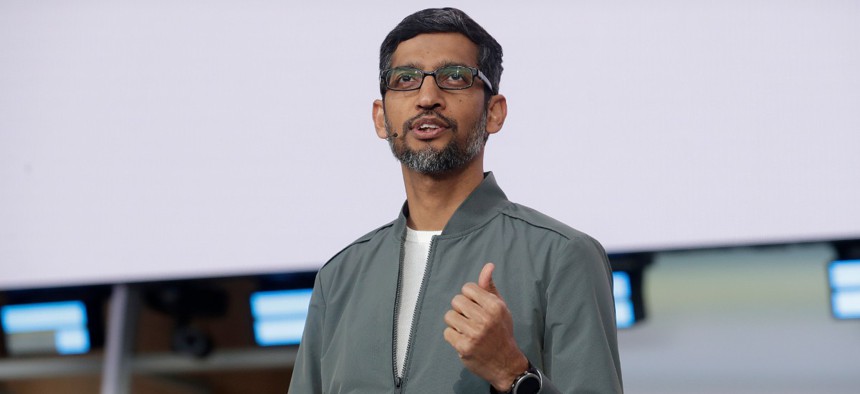How the Government Helped Google Reach Quantum Supremacy

Google CEO Sundar Pichai Jeff Chiu/AP
Insiders from both the tech giant and the government detailed how the breakthrough was made possible through public-private collaboration.
Google officially announced Wednesday that it’s reached quantum supremacy—and the White House was quick to weigh in.
United States Chief Technology Officer Michael Kratsios published an op-ed the same morning, asserting Google’s discovery and emphasizing that it was made possible through support from academia and the Trump administration. The Office of Science and Technology Policy simultaneously issued its own, similar statement by email.
“No one entity could have achieved this historic milestone on its own,” Kratsios said in his article, entitled “How America Achieved ‘Quantum Supremacy.’” “Instead, academic, industrial, and government teams worked together from the bottom up to push the boundaries of science and unlock new potential for human advancement.”
The tech giant rattled the science community in September, when a paper detailing the accomplishment was reportedly published on NASA’s website, then pulled—but not before journalists took note. Google unveiled the breakthrough exactly one month after the date, indicating that Sycamore, its own quantum computer, proved the theory of quantum supremacy by performing a calculation in 200 seconds that the company said would take a “state-of-the-art classical supercomputer” approximately 10,000 years.
“This dramatic increase in speed compared to all known classical algorithms is an experimental realization of quantum supremacy for this specific computational task, heralding a much-anticipated computing paradigm,” the Google AI Quantum Team said in the paper, which it published in scientific journal Nature.
While there’s currently no practical use for the milestone, much is at stake as countries and companies compete across the quantum landscape. The emerging technology is anticipated to radically transform modern communication and security, accelerate powerful new discoveries and support the design of first-of-a-kind chemicals and materials. For those reasons and beyond, the federal government said it is committed to establishing American leadership in the quantum space. Over the last year, President Trump signed an executive order establishing the first quantum coordination office in OSTP and allocating $1.2 billion for quantum-focused research and development over the next five years.
“To prove the theory of quantum supremacy, Google’s research team built upon foundational research at government laboratories,” Kratsios noted in his oped.
The federal CTO said the company launched quantum efforts at the University of California at Santa Barbara, with research support from the Intelligence Advanced Research Projects Activity and National Science Foundation. Google also depended on the Energy Department’s Summit supercomputer, as well as federal experts at the NASA Quantum Artificial Intelligence Laboratory “to tackle the herculean task of verifying the quantum algorithm.”
A Google spokesperson also told Nextgov that the federal and academic support was instrumental to make way for the breakthrough. The official said that the company collaborated with NASA Ames Research Center, Oak Ridge National Laboratory, and Forschungszentrum Jülich, a major interdisciplinary research center based in Europe, on the paper.
“All three organizations have deep experience in high-performance computing, and helped develop classical quantum circuit simulators that helped us validate our quantum supremacy claim,” the spokesperson said.
They added that NASA, in particular, was the main developer of the simulator that was able to validate Google’s supremacy claim using ORNL’s Summit supercomputer, which the spokesperson noted is the first on the list of the top 500 supercomputers. And on top of the hardware effort growing out of UCSB with critical financial support from NSF, the spokesperson added that Google has also been working with the National Institute of Standards and Technology as it’s exploring applications of the budding technology.
"We appreciate all the help and support we’ve gotten along the way,” the company’s spokesperson said.
But the announcement did not come without controversy. IBM, one of Google’s top quantum competitors, published an article Monday disputing Google’s initial claims and arguing that a classical system can actually perform the same task in two and a half days.
“This is in fact a conservative, worst-case estimate, and we expect that with additional refinements the classical cost of the simulation can be further reduced,” members of IBM’s research staff said.
But Google is standing by the discovery. CEO Sundar Pichai addressed IBM’s claim that the term “quantum supremacy” is misleading in an interview with MIT Technology Review Wednesday.
“My answer on that would be, it is a technical term of art,” Pichai said. “People in the community understand exactly what the milestone means.”
And members across the global quantum community already seem to be energized by the announcement. Michael Biercuk, experimental quantum physicist and founder and CEO of Q-CTRL, a Sydney, Australia-based quantum computing startup that recently opened offices in Los Angeles, told Nextgov that the demonstration marks an important incremental step in the long-running effort to build useful quantum technology.
“This achievement, if it holds up under the intense scrutiny that is sure to follow, represents a landmark academic achievement relating to the overall value of quantum computers,” Biercuk said. “Accordingly, this really takes the legs out from under the few naysayers claiming quantum computers have no future.”
And for Google, Pichai said this is only the beginning. Quantum computing holds as much promise for the company’s future as other groundbreaking technologies, such as artificial intelligence. Pichai also compared the newly-unveiled breakthrough to the Wright brothers’ monumental first flight.
“The first plane flew only for 12 seconds, and so there is no practical application of that,” he said. “But it showed the possibility that a plane could fly.”
RELATED






